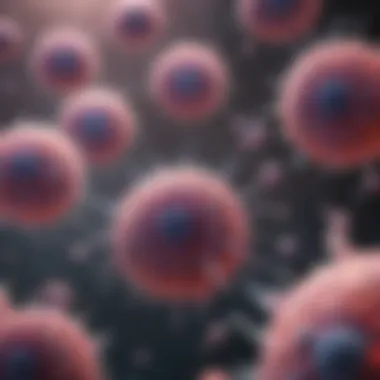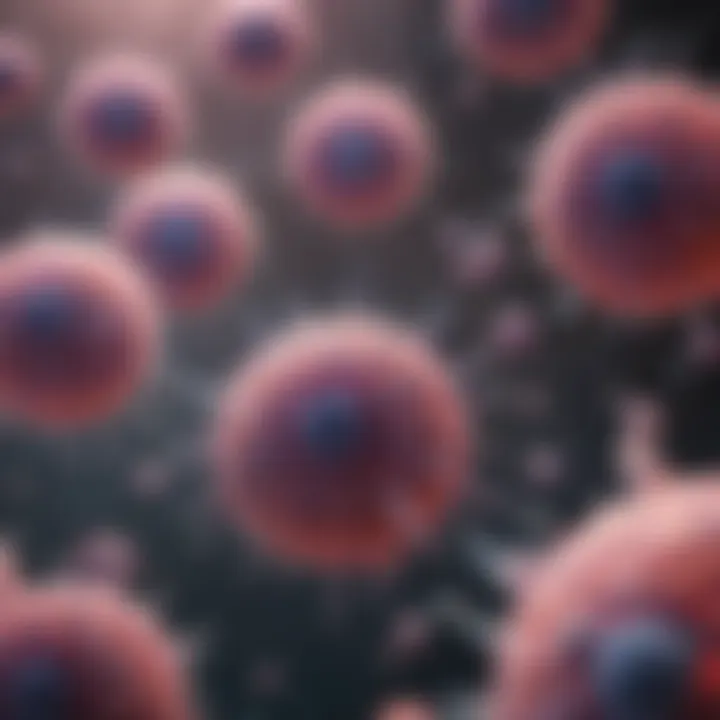Exploring the Impact of Oxygen in Cancer Therapy


Intro
Cancer remains a significant global health challenge, and understanding its complexities can lead to improved treatment strategies. One crucial aspect that has garnered attention is the role of oxygen in cancer treatment. Oxygen's various forms of therapy have shown promise in influencing tumor behavior and enhancing therapeutic efficacy. This overview will examine how different oxygen modalities can impact treatment outcomes for cancer patients.
Summary of Objectives
This article aims to delineate the complex relationship between oxygen levels within tumor environments and the effectiveness of cancer therapies. It seeks to illustrate how oxygen therapy can potentially improve patient outcomes.
Importance of the Research
The exploration of oxygen's role in cancer treatment is imperative. It not only seeks to enhance our understanding of tumor biology but also aims to inform clinical practices. By identifying optimal oxygen levels for therapies, researchers can potentially improve the therapeutic index of existing cancer treatments.
Results and Discussion
Presentation of Findings
Recent studies have shown a direct correlation between oxygen availability and the success of radiotherapy and chemotherapy. Tumors often exist in hypoxic (low-oxygen) environments, which can lead to treatment resistance. The introduction of normobaric and hyperbaric oxygen therapies has garnered interest due to their potential in mitigating this issue.
Key Points:
- Normobaric Oxygen Therapy: This involves delivering oxygen at normal atmospheric pressure, enhancing oxygen availability to tissues during treatment.
- Hyperbaric Oxygen Therapy: This includes administering oxygen in a pressurized environment, further increasing tissue oxygenation.
Implications of Results
The implications of these findings are significant. Enhanced oxygenation can improve the efficacy of radiation therapy by increasing tumor sensitivity and reducing resistance. Furthermore, combining oxygen therapies with chemotherapy can lead to improved cancer cell kill rates. However, practitioners should remain aware of possible risks associated with different therapy applications, including oxygen toxicity and combustion hazards.
"Oxygen's biochemistry in relation to tumor dynamics cannot be overstated; it is fundamental to the future of effective cancer treatment strategies."
Epilogue
In summary, the application of oxygen therapies holds potential to reshape cancer treatment paradigms. Ongoing research is critical to further elucidating the biological mechanisms at play and to optimize protocols for better patient outcomes. As we advance in this field, the integration of oxygen therapies could represent a pivotal step in enhancing the efficacy of current cancer treatments.
Preamble to Oxygen in Cancer Treatment
Oxygen is a fundamental component in the realm of cellular biology and biochemistry. Its significance extends profoundly into the treatment of cancer, a disease characterized by uncontrolled cell growth. Understanding the role of oxygen in cancer treatment is crucial as it can influence both tumor progression and the efficacy of various therapeutic modalities. This article examines the multifaceted implications of oxygen, inviting a discussion on how oxygen therapy may reshape treatment strategies for cancer patients.
Specific elements of oxygen therapy that require careful consideration include its biological mechanisms, historical context, and contemporary applications in clinical settings. Among the benefits, increasing oxygen levels in tumors may improve drug delivery, enhance the effects of radiotherapy, and possibly mitigate hypoxia-related resistance mechanisms in tumor cells. Each of these aspects contributes to a broader understanding of how oxygen levels affect cancer treatment outcomes.
Overview of Oxygen's Biological Role
Oxygen plays a pivotal role in cellular respiration, allowing for the production of ATP, which is essential for energy transfer within cells. In healthy tissues, adequate oxygen levels promote normal metabolic processes. However, in cancerous tissues, the situation often varies. Tumor hypoxia, or low oxygen conditions, can lead to increased malignancy and resistance to standard treatments. The lack of oxygen can cause cancer cells to adapt, making them more aggressive and harder to treat.
The distinction between normoxic and hypoxic environments within tumors highlights the complexity of cancer biology. In normoxic conditions, therapies like chemotherapy and radiotherapy can be more effective, as oxygen is a potent radiosensitizer. Conversely, in hypoxic environments, the same treatments may be less effective, necessitating a strategic approach that incorporates oxygen therapy to normalize tumor oxygen levels.
Historical Context of Oxygen in Oncology
The exploration of oxygen's role in oncology has evolved over the last century. Initially, the focus was primarily on the adverse effects of hypoxia on tumors. Early theories proposed that oxygen deprivation was a significant factor in tumor progression and treatment resistance. Groundbreaking research in the mid-20th century underscored the need for oxygen to bolster the effectiveness of radiotherapy, paving the way for the incorporation of oxygen therapy in clinical practices.
As research advanced, various forms of oxygen therapy emerged, including normobaric and hyperbaric oxygen treatments. These modalities aimed to enhance the oxygen availability in the tumor microenvironment. Today, the integration of oxygen therapy into cancer treatment protocols is gaining attention as studies continue to demonstrate its potential to improve outcomes for patients. The historical journey of oxygen in oncology reflects a growing understanding of its importance and the necessity to address hypoxia in cancer management.
Oxygen and Cancer Biology
Oxygen plays a critical role in cancer biology, impacting various cellular processes that can influence tumor development and treatment efficacy. Understanding the relationship between oxygen levels and cancer growth is essential not only for researchers but also for clinicians who aim to optimize treatment approaches. The benefits of properly managed oxygen levels extend to enhancing the effectiveness of therapies such as chemotherapy and radiotherapy, while the considerations of oxygen consumption and availability in tumor organs can influence strategies for disease management.
Cellular Respiration and Cancer Growth
Cellular respiration is fundamental to how cancer cells produce energy. In healthy cells, oxygen is vital for aerobic respiration, a process that efficiently generates ATP, the energy currency of cells. Cancer cells, however, often exhibit altered metabolism, favoring anaerobic processes even in the presence of oxygen. This phenomenon, known as the Warburg effect, means that cancer cells rely heavily on glycolysis, which occurs in the cytoplasm and produces less ATP than aerobic respiration.
Research indicates that the presence of sufficient oxygen can aid in reversing these metabolic adaptations. Increasing oxygen availability can enhance cellular respiration in tumor environments, potentially rendering tumor cells more sensitive to chemotherapy and radiotherapy. This highlights how oxygen therapy may help restore a more normal metabolic state in malignant cells, thereby augmenting treatment effectiveness.
Hypoxia in Tumor Environments
Hypoxia, a condition of low oxygen availability, is commonly observed in tumors. This reduced oxygen state results from an imbalance between oxygen supply and demand, primarily due to rapid tumor growth and abnormal blood vessel formation. Hypoxia not only promotes cancer progression but also leads to resistance against various treatment modalities.


Tumors that are hypoxic tend to exhibit increased aggressiveness and higher tendencies for metastasis. Moreover, hypoxic cells are less responsive to radiation therapy, as reduced oxygen levels diminish radiation's effectiveness. This situation creates a challenging scenario where tumor cells can evade treatment and adapt to hostile microenvironments.
Moreover, understanding hypoxia's impact on cancer biology has led to strategies designed to improve treatment outcomes. Approaches such as targeted oxygen therapy aim to alleviate hypoxia in tumors, thereby enhancing the performance of existing therapies. Recognizing and addressing hypoxia is vital in developing holistic cancer treatment protocols that take into account the intricate relationship between oxygen and tumor biology.
"Hypoxia is not just a mere byproduct of tumor growth; it’s a significant factor influencing treatment responses and clinical outcomes."
Forms of Oxygen Therapy
Oxygen therapy encompasses diverse methods utilized in clinical settings to optimize oxygen delivery to tissues. Understanding different forms of oxygen therapy is crucial for medical professionals and researchers focusing on cancer treatment. Each method has distinct applications, advantages, and practical considerations, which merit careful examination.
Normobaric Oxygen Therapy
Normobaric oxygen therapy (NBOT) involves administering oxygen at normal atmospheric pressure. This form is widely used and typically administered through devices like nasal cannulas, face masks, or other oxygen-delivering apparatus.
NBOT significantly enhances oxygenation in patients who may have insufficient lung function. It can help in managing hypoxia, ensuring that vital organs receive the oxygen they need. Notably, studies suggest that normobaric oxygen therapy can synergize with chemotherapy and radiotherapy, potentially leading to improved treatment outcomes.
Benefits of Normobaric Oxygen Therapy:
- Increases available oxygen for cellular processes.
- May improve responsiveness to chemotherapeutic agents.
- Easier to administer compared to other methods.
However, clinicians should also evaluate individual patient circumstances. Considerations such as preexisting conditions and potential complications must be accounted for before initiating treatment.
Hyperbaric Oxygen Therapy
Hyperbaric oxygen therapy (HBOT) involves delivering oxygen in a pressurized environment, typically within a sealed chamber. This method allows for significantly higher oxygen concentrations in the bloodstream compared to normal atmospheric pressure. HBOT has been investigated for various applications in oncology.
This form of therapy can enhance the effectiveness of certain cancer treatments, particularly in patients with radiation-induced injuries. The application of HBOT has shown promise in reducing damage to healthy tissues adjacent to tumors, thereby improving overall patient quality of life.
Considerations for Hyperbaric Oxygen Therapy:
- Requires specialized facilities and equipment.
- Potential for complications, including oxygen toxicity.
- Not suitable for all patients; thorough assessment is necessary.
Benefits of Hyperbaric Oxygen Therapy:
- Promotes wound healing, especially in post-radiation contexts.
- Can stimulate angiogenesis, possibly benefiting tumor control.
Oxygen Supplementation Techniques
Oxygen supplementation techniques encompass a range of methods designed to enhance systemic oxygen levels. Such techniques can be crucial for oncology patients facing hypoxia, which can hinder treatment efficacy.
Common methods include the use of high-flow nasal cannula systems, oxygen concentrators, and portable oxygen tanks. These methods can be tailored to meet the specific needs of each patient, ensuring that their oxygen levels are maintained during critical treatment phases.
Key Techniques in Oxygen Supplementation:
- High-Flow Nasal Cannula: Delivers heated and humidified oxygen at substantial flow rates.
- Oxygen Concentrators: Extracts and concentrates oxygen from the surrounding air, providing continuous dose.
- Portable Oxygen Tanks: Offers flexibility for patients requiring oxygen while maintaining mobility.
Oxygen supplementation techniques are essential for improving patient outcomes. Close monitoring of individual patient responses to these therapies enables healthcare providers to adjust strategies as necessary.
Impact of Oxygen on Cancer Treatments
The role of oxygen in cancer treatments is critical. Oxygen enhances various therapeutic approaches by improving efficacy and outcomes. Understanding how oxygen interacts with chemotherapy and radiotherapy is essential for optimizing treatment strategies for cancer patients.
Enhancing Chemotherapy Effects
Chemotherapy is often compromised by tumor hypoxia, where low oxygen levels inside tumors reduce drug effectiveness. Oxygen can reverse this hypoxic state. When supplemental oxygen is introduced, it can improve the perfusion of chemotherapeutic agents by enhancing blood circulation, allowing higher concentrations of drugs to reach the tumor.
Research shows that treatments combining oxygen and chemotherapy can lead to higher response rates in some cancers. For example, studies involving breast and prostate cancers have illustrated these improved outcomes. Moreover, oxygen can enhance the prostate-specific antigen (PSA) response, enabling better monitoring of the treatment's effectiveness.
Oxygen in Radiotherapy
In the context of radiotherapy, oxygen plays a crucial role in the effectiveness of ionizing radiation. Radiotherapy relies on the generation of reactive oxygen species (ROS) to damage the DNA of cancer cells. When tumors are adequately oxygenated, the likelihood of significant DNA damage increases. This mechanism is pivotal in enhancing tumor control while minimizing damage to surrounding healthy tissue.
Additionally, combining oxygen with radiotherapy has shown potential in increasing local control rates. Clinical data support that hypoxia radiosensitizers, or agents that help tumors use oxygen more effectively during radiation, can lead to improved outcomes in head and neck cancers.


Potential Benefits and Limitations
While the integration of oxygen into cancer treatments presents promising prospects, there are considerations and limitations.
Benefits:
- Increased efficacy of radiotherapy and chemotherapy.
- Potential to overcome resistance in certain tumors.
- Improved tumor oxygenation leads to better therapeutic responses.
Limitations:
- Not all tumors respond uniformly to oxygen therapy; some may still exhibit hypoxia despite treatment.
- Adverse effects and risks associated with high oxygen levels need management.
- More research is required to identify optimal delivery methods and dosage.
In summary, the impact of oxygen in cancer treatments is significant, particularly concerning enhancing the effectiveness of both chemotherapy and radiotherapy. As research continues, understanding these implications will be vital for developing more effective treatment modalities.
Research Developments in Oxygen and Cancer
The relationship between oxygen and cancer is gaining increasing attention in oncology. Research plays a crucial role in understanding how oxygen can be utilized in treatment strategies. Optimizing oxygen levels in tumors can enhance therapeutic effects and potentially improve survival rates for patients. In recent years, the focus has shifted to how scientific advancements in oxygen therapy can translate into clinical benefits. This section highlights critical elements of research in this area, discussing recent clinical trials, ongoing initiatives, and innovations in oxygen delivery systems.
Recent Clinical Trials
Clinical trials are fundamental for evaluating the safety and efficacy of new treatment methods involving oxygen therapy. Several recent studies have explored the impact of oxygen on various cancer types. For instance, a trial on hyperbaric oxygen therapy (HBOT) in patients with head and neck cancers has shown promising results in reducing tumor hypoxia. This condition commonly limits the effectiveness of treatments such as radiotherapy. Providing higher oxygen concentrations in a controlled environment may improve the radiosensitivity of tumor cells.
Additionally, a normobaric oxygen therapy (NBOT) trial demonstrated that maintaining oxygen levels during chemotherapy could enhance drug cytotoxicity, leading to better treatment outcomes in breast cancer patients. Each trial contributes unique data to the body of work on how oxygen therapy can manipulate the tumor microenvironment to favor treatment efficacy.
Ongoing Research Initiatives
Numerous research initiatives are currently underway, focusing on understanding the mechanisms by which oxygen interacts with cancer therapies. One notable effort involves studying oxygen diffusion in tumors. Researchers are investigating how variations in blood flow and oxygen distribution affect tumor response to therapies. Enhanced imaging technologies are playing a vital role here, enabling real-time monitoring of tissue oxygen levels.
Organizations like the National Cancer Institute and various universities are conducting comprehensive projects that aim to innovate oxygen therapies. These initiatives often involve multidisciplinary teams working together to explore the biological effects of oxygen at cellular levels. They also aim to identify patient subgroups that can benefit most from oxygen-based interventions due to genetic or epigenetic factors.
Innovations in Oxygen Delivery Systems
Advancements in technology are paving the way for new oxygen delivery systems that are more effective and user-friendly. Innovations such as portable oxygen concentrators and improved pressurized devices are allowing for customized patient treatment.
- Wearable oxygen devices are being designed to monitor real-time oxygen saturation and deliver appropriate levels during activities, allowing for increased mobility for cancer patients.
- Nanoparticle technology is also gaining traction; it provides a means to directly deliver oxygen to tumor sites through targeted systems, increasing precision in treatment.
The future of oxygen delivery systems seems bright, with researchers aiming to combine these innovations with targeted therapies. Combining different treatment modalities and technologies has the potential to disrupt traditional paradigms in cancer treatment entirely.
Improved understanding of how oxygen functions within the tumor microenvironment can lead to groundbreaking treatment approaches that better align with individual patient needs.
Safety and Contraindications
The safety and contraindications regarding oxygen therapy in cancer treatment are critical topics that deserve careful examination. Understanding the potential adverse effects and managing risk effectively are vital for optimizing treatment outcomes while safeguarding patient health. Oxygen therapy, while valuable, can lead to complications that practitioners must recognize and address. The balance between benefits and risks is delicate, and the proper protocols must be implemented to ensure patient safety.
Adverse Effects of Oxygen Therapy
Oxygen therapy can bring several adverse effects, which vary based on the method of delivery and the individual patient's condition. Common side effects include:
- Oxygen Toxicity: Prolonged exposure to high concentrations of oxygen can lead to toxicity, affecting the lungs and central nervous system. It can manifest as respiratory distress or seizures in severe cases.
- Barotrauma: This risk is particularly relevant in hyperbaric oxygen therapy, where changes in pressure can cause physical damage to the lungs or middle ear.
- Fatigue or Headaches: Some patients report fatigue or headaches, likely related to variations in oxygen levels in the bloodstream.
- Infection Risk: Using oxygen devices can increase the risk of infections, especially if adequate sterilization is not maintained.
It is essential for clinicians to weigh these risks against the potential benefits of oxygen therapy, often requiring regular monitoring of patients receiving such treatments.
Risk Management in Treatment Settings
Effective risk management strategies are critical to minimize complications arising from oxygen therapy. Healthcare professionals should consider the following strategies:
- Regular Patient Monitoring: Continuous assessment of a patient’s oxygen levels and overall condition can help catch any adverse effects early. Employing pulse oximetry and blood gas analysis aids in this monitoring.
- Training and Education: Staff should receive proper training in delivering oxygen therapy. This includes knowledge of different therapies available, recognizing signs of adverse reactions, and appropriate responses to emergencies.
- Patient Education: Informing patients about potential side effects and warning signs is crucial. Adopting a protocol that includes discussions about risks can empower patients in their care.
- Tailored Treatment Plans: Personalizing oxygen therapy protocols based on individual patient conditions and medical histories can reduce risks and promote safer practices.
Implementing these risk management strategies can substantially decrease the likelihood of adverse events. Striking a balance between effective treatment delivery and patient safety is the ultimate goal of oxygen therapy in cancer care.
"Oxygen therapy must be approached with caution, ensuring benefits significantly outweigh any associated risks."
Undoubtedly, the field of oxygen therapy in cancer treatment is evolving. Future research will likely unveil more about how to safely leverage oxygen to enhance treatment effects while minimizing the drawbacks.


Patient Considerations and Guidelines
In the sphere of cancer treatment, patient considerations and guidelines are essential. These factors play a pivotal role in ensuring that oxygen therapies are applied effectively and that patients receive the maximum benefit from these treatments. Understanding individual patient needs allows healthcare providers to tailor approaches that address specific medical histories, types of cancer, and overall health conditions. This targeted treatment not only enhances the efficacy of therapies but also improves the patient's quality of life.
Individual Patient Assessments
Assessing an individual patient is fundamental for optimizing oxygen therapy in cancer treatment. Each patient's response to oxygen varies, influenced by numerous factors such as tumor type, stage of disease, and pre-existing health conditions. An initial evaluation should focus on the patient's full medical history, their current physical health, and any ongoing treatments.
- Key aspects to consider in assessments include:
- Type of cancer
- Stage of cancer
- Hypoxia levels in tumors
- Patient's respiratory function
- Comorbidities, such as cardiovascular diseases
These assessments can help healthcare professionals identify the most suitable oxygen therapy. For instance, patients with lung cancer might require different considerations than those with breast cancer. Comprehensive evaluation fosters informed decisions, guiding treatment modifications if necessary.
Guidelines for Implementation
The implementation of oxygen therapy in cancer treatment requires adherence to established guidelines to mitigate risks and enhance treatment outcomes. Clear protocols ensure that therapies align with the patient's needs while minimizing potential complications.
Important guidelines include:
- Clinical Protocol Development: Establish processes tailored to the specific cancer type and patient conditions.
- Monitoring and Evaluation: Continuous observation of the therapy's effectiveness should be a priority, adjusting based on patient response.
- Patient Education: Informing patients about the purpose, process, and potential side effects of oxygen therapy, enhancing compliance and satisfaction.
- Collaboration Among Healthcare Providers: Multi-disciplinary teams should work together to create a cohesive treatment approach, integrating insights from oncologists, respiratory therapists, and nursing staff.
Implementing these guidelines can lead to more successful outcomes, ensuring that patients receive the most effective oxygen therapy. Encouraging thorough documentation and consistent follow-ups also plays a critical role in refining ongoing treatment strategies.
"Patient-centric care in oxygen therapy can drastically change outcomes in cancer treatment, highlighting the significance of personalized approaches."
By aligning treatment with the specific needs of each patient, the healthcare community can facilitate advancements in cancer care, significantly improving the therapeutic landscape.
Future Directions in Oxygen Research
The exploration of oxygen's role in cancer treatment is an evolving field. Recent advances in research indicate that oxygen could dramatically change how we approach cancer therapies. The growing understanding of oxygen's biological implications and its potential therapeutic benefits warrants a closer examination of future directions in oxygen research. This section delves into emerging paradigms and the role of personalized medicine, both crucial components that are reshaping cancer treatment landscapes.
Emerging Paradigms in Cancer Treatment
As the field of oncology progresses, new paradigms are emerging regarding the application of oxygen in treatment protocols. One notable trend is the integration of oxygen therapy within cancer treatment regimens. This integration acknowledges that oxygen levels can influence tumor behavior and treatment efficacy. Enhanced oxygen delivery systems are being developed to ensure better distribution of oxygen in hypoxic tumor environments, making it essential for research to continue exploring mechanisms that can maximize oxygen delivery and utilization.
Future studies are focusing on the synergy between oxygen therapy and existing treatments, such as chemotherapy and immunotherapy. For instance, increasing oxygen supply may sensitize tumors to chemotherapeutic agents. This could potentially lead to improved treatment outcomes. Monitoring biological markers related to hypoxia in tumors can also provide insights into patient responses, allowing adjustments in therapy that align with individual tumor biology.
Additionally, researchers are investigating newer oxygen-based compounds that could serve as adjunct treatments. These compounds may reduce the adverse effects of established therapies, providing a more holistic approach to cancer care. Overall, as evidence mounts regarding the relationship between oxygen levels and cancer treatment efficacy, integrating these emerging paradigms will likely refine our understanding and application of oxygen therapies in clinical settings.
The Role of Personalized Medicine
Personalized medicine is becoming a cornerstone in modern cancer care. This approach tailors treatment based on individual patient profiles, including genetic, environmental, and lifestyle factors. The implementation of oxygen therapy within the framework of personalized medicine presents opportunities for more effective and targeted therapeutic strategies.
For instance, understanding the unique hypoxic characteristics of a patient’s tumor can inform how oxygen therapy is used. Genetic markers and metabolic profiles can indicate whether enhancement of oxygen levels is likely to improve treatment outcomes. By aligning oxygen delivery systems with a patient's specific tumor biology, healthcare providers can strategically enhance treatment efficacy while minimizing risks.
Moreover, ongoing research is set to identify biomarkers that predict response to oxygen therapies. This knowledge could lead to the development of protocols that systematically incorporate personalized oxygen therapy into treatment plans.
"The potential for personalized applications of oxygen therapy could change entire treatment paradigms in oncology, emphasizing the need for research that bridges these two important areas."
Closure and Implications
The exploration of oxygen's role in cancer treatment illustrates its critical importance in therapeutic outcomes. Oxygen therapy not only serves as a supportive treatment but also enhances the effectiveness of conventional methods like chemotherapy and radiotherapy. It has been established that sufficient oxygen levels within tumor environments can lead to improved responses to treatment, ultimately contributing to better patient prognoses.
Summary of Key Insights
This article presented several key insights regarding oxygen in cancer treatment:
- Biological Function: Oxygen plays a vital role in cellular respiration and energy production, which are essential for cancer cell growth.
- Therapeutic Approaches: Normobaric and hyperbaric oxygen therapies have been highlighted for their potential to mitigate hypoxic conditions in tumors.
- Research Significance: Recent clinical trials have shown that oxygen therapy can meaningfully enhance the effectiveness of chemotherapy and radiotherapy, though the results are varied.
- Safety Measures: Understanding adverse effects and risk management strategies is crucial for the safe application of oxygen therapy in clinical settings.
These elements underscore the multifaceted role of oxygen, making it a significant focus for future cancer treatment advancements.
Implications for Future Cancer Research
The findings surrounding oxygen therapy present numerous implications for the ongoing and future research in oncology:
- Further Investigations: Continued research is necessary to better understand the optimal delivery methods and dosages of oxygen in various cancer contexts.
- Targeted Therapy Development: Personalizing oxygen therapy combined with other treatments may enable more precise and effective interventions, addressing patient variability in treatment responses.
- Integration with New Technologies: Exploring how advanced oxygen delivery systems can enhance tumor oxygenation could lead to breakthroughs in treatment efficacy.
- Longitudinal Studies: Conducting long-term studies to evaluate the effects of oxygen therapy on survival rates and quality of life will provide valuable data for clinical practices.
In summary, oxygen therapy's potential continues to expand as a complementary strategy in cancer treatment. As researchers explore the implications of oxygen in oncology, it could redefine therapeutic paradigms and significantly affect clinical outcomes, all while ensuring patient safety.















